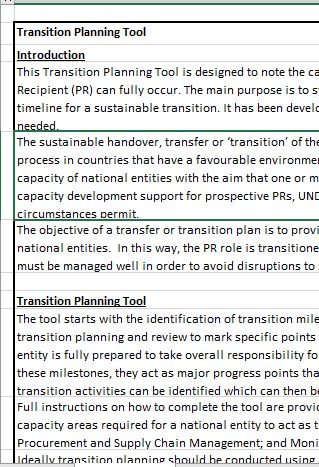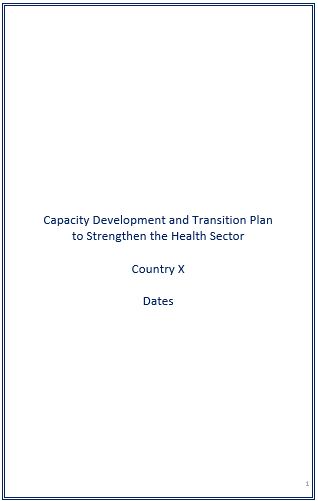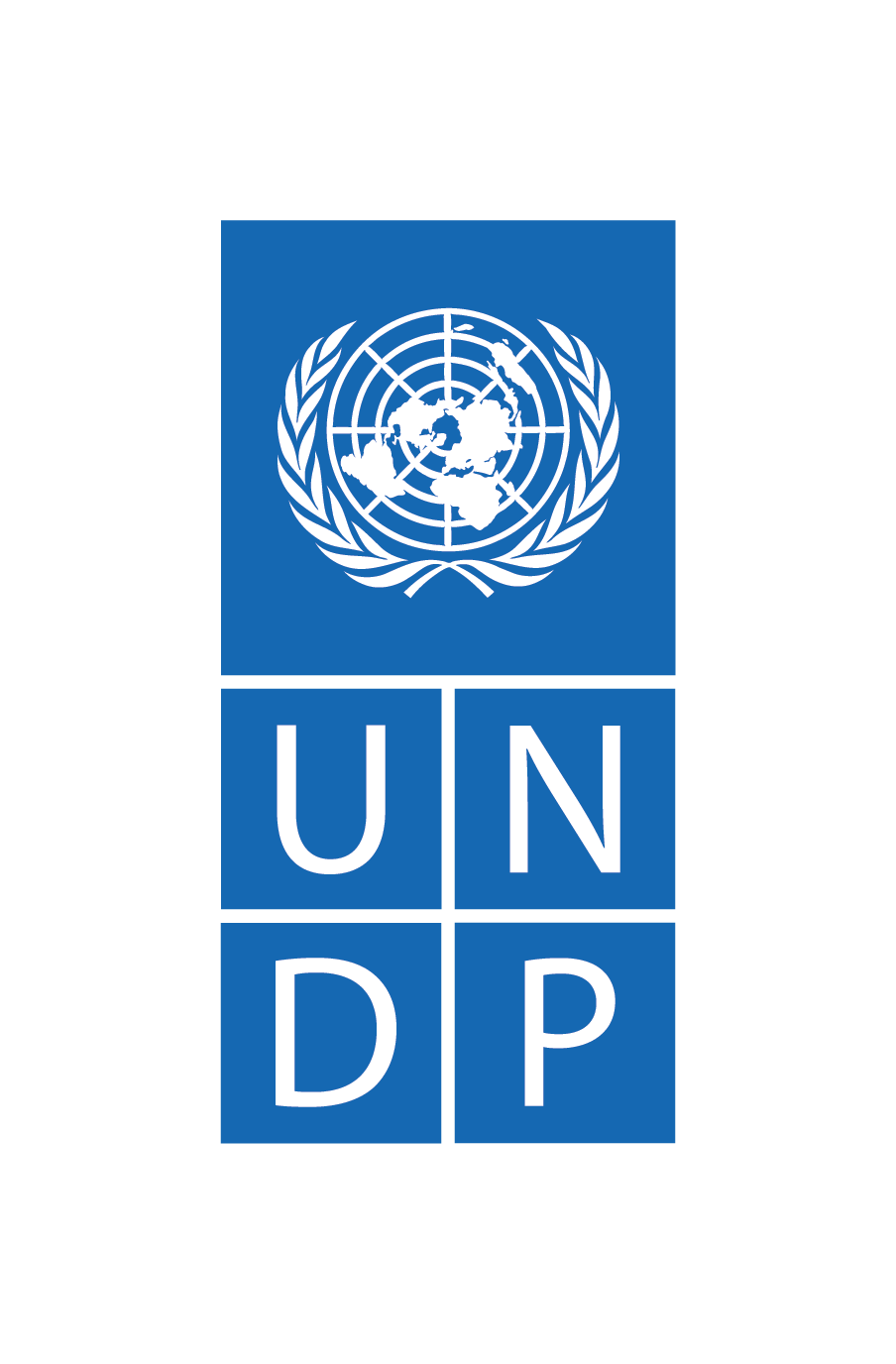Transition plans for the Global Fund and other health programmes
Transition planning should ideally be conducted at the beginning of a grant with the identification of a future national organization to assume management of the grant, at the same time as capacity development planning. In this way, selected capacity development planning milestones become transition “triggers” for certain functions. When planning a programme transition process, the first step is to consider what the transition options are and what criteria will be used to evaluate the options. Based on this information, a programme transition strategy can be developed to guide the process. A detailed programme transition plan outlines all activities that are required to transition the grant management role from UNDP to one or more national entities, with a clear timeline for implementation.
UNDP’s approach
When serving as interim Principal Recipient of a Global Fund to Fight AIDS, Tuberculosis and Malaria (The Global Fund) programme, UNDP works in partnership with country stakeholders from the start of the grant to establish the necessary capacities, systems and processes to enable the sustainable transition of programmes to national entities. It leverages existing tools and frameworks to help governments establish transition plans, with measurable milestones and concrete timelines, to ensure a tailored and gradual approach to the transition.
UNDP provides ongoing technical assistance beyond any handover to continue to develop the capacity of national entities. In many countries, UNDP does this through an advisory role, including through health coordinating mechanisms such as the Global Fund Country Coordinating Mechanisms or directly to implementing partners. UNDP also provides substantial health procurement support to national governments, including strengthening supply chains to ensure uninterrupted access to quality-assured medicines, continuing to procure health products after the transition to other functions.
UNDP places particular emphasis on supporting national entities to sustain HIV and other essential services for key and vulnerable populations and promote gender equity in disease responses. To this end, it helps to conduct transition readiness assessments that examine the legal and policy environments influencing access to health services, including structures that empower civil society organizations (CSO), which are often crucial to the success of health programmes in countries where key populations are disproportionately affected by the three diseases and are criminalized or marginalized. Strengthening the capacity of civil society implementing partners while donors are still present can help to ensure that CSOs are prepared to deliver services adequately and to advocate for their sustained financing after the exit of external financing. Visit the “Social contracting” page for more details on strengthening public funding for CSO service delivery. The “Human rights and legal environment” page offers guidance on UNDP’s work to strengthen legal and policy environments for key populations and other vulnerable groups, whether in the context of a programme transition or through technical assistance to national partners.
In addition, UNDP supports countries in planning and transitioning from donor support to domestically funded health programmes by analysing domestic funding options and revenue generation strategies and supporting investment cases to strengthen advocacy for health financing. See the “Sustainable financing” page for more information.
Tools and guidance
UNDP has designed a range of tools, guidance and templates to support transition processes for the Global Fund grants, which have been tested in a number of countries and can be adapted for the country context. This includes a comprehensive framework and tools for the development of a programme transition plan or strategy, as available in the key resources below. The objective of a transition plan is to design a staggered process to allow for grant management responsibilities to move from UNDP to the national entities, developing capacity where required during this time.
As part of its transition planning approach, UNDP helps partners to 1) establish management arrangements, including, where relevant, by setting up programme management units within ministries of health; 2) identify milestone indicators, transition schedules and risk mitigation measures; 3) develop budget estimates; and 4) generate consensus and approval among key stakeholders.
Further detail on the steps and considerations for carrying out a programme transition process can be found in the UNDP guidance on planning and implementing a programme transition strategy for Global Fund grants.
Some key points to consider in designing and implementing a transition plan include the following:
- Where possible, planning for transition should be done at the same time as capacity development planning, to define the desired capacity in each area and to set measurable milestones for the transfer of responsibilities. This may not always be possible, and, if not, a schedule for developing a transition plan should be included in the capacity development plan. Implementation of the transition plan can start when the capacity is strengthened.
- While a capacity development plan is owned by the national entity, a transition plan is jointly owned and managed by both the national entity and UNDP. Both organizations have important responsibilities to ensure a successful and sustainable handover of the grant management role. There are linkages between the capacity development plan and a transition plan, in that some transition activities may not be completed until capacity is strengthened.
- The completion of a transition is sometimes dependent on capacity being developed and, following this, agreement from the donor that the national entity now has the required capacity to manage the grant. As with all capacity development, the focus should be on the development of national systems as opposed to stand-alone systems to manage a single grant.
- A programme transition or transfer plan should also include a risk assessment, identifying possible risks associated with moving responsibility for essential health services from one grant manager to another and finding strategies to deal with these risks. The management of these risks should be monitored and controlled by the group overseeing the implementation of the capacity development.
Key resources

Transition Framework
The sustainable transition or handover of the Principal Recipient (PR) role from UNDP to one or more national entities can be one of the results of a capacity development process. MS Excel

Transition Plan Template
This tool is designed to note the capacity of potential PRs and to detail activities that need to take place before transition to a new Global Fund PR can fully occur.
MS Excel

Transition & Systems Development Planning Tool
This tool details milestones and activities that need to take place before the transition to a new Global Fund PR can fully occur.
MS Excel

Transition Plan Narrative Report Template
This template was created to strengthen capacity development and transition planning in the health sector.
MS Word

Example Objectives and Milestones for Transition
This lists the objectives for financial management systems, procurement and supply management, monitoring and evaluation, and project governance and programme management.
MS Word

Example Capacity Development for Transition Activities
This explores activities for areas such as management mechanism, human resources set-up, legal, systems and procedures, financial management and monitoring and evaluation.
MS Word

Transition Milestones Examples
The transition milestones were developed to measure the successful implementation of the Transition of the PR to national entities.
MS Word
